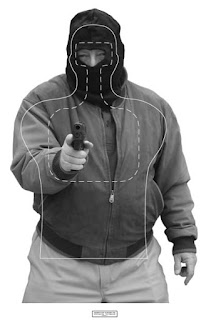This is the US Department of Energy (DOE) Protective Force Shotgun Qualification. The Department of Energy Protective Force Teams are the guys and gals that guard nuclear weapons and nuclear facilities—they are serious. The course of fire is straight forward and requires ten rounds of buckshot. The DOE qualification is fired on the DOE standard target with all pellets on the target counted as one point. The shooter must score 90% to pass at the SPO-III or Special Response Force/Tactical Response Force level.
The Stages:
7 yard line - 4 Rounds:
-- Shotgun Loaded with 3 rounds
-- Charge, and fire 2 rounds. Load 1 round in the magazine tube, and fire 2 rounds
Time: 12 Seconds
15 yard line – 4 Rounds:
-- Shotgun Loaded with 2 rounds
-- Charge, and fire 2 rounds from a standing position.
-- While kneeling, load 1 round through the ejection port and close the action, load 1 round in the magazine tube, and fire 2 rounds
Time: 15 seconds
25 yard line - 2 shots:
-- Shotgun loaded w/ 2 rounds
-- From standing, Charge and fire one round, kneel and fire one round
Time: 6 Seconds
I fired the qualification using the DOE standard target. I covered the target with a t-shirt to reduce the damage the shotgun wads cause (even so, the large gaping holes are from the impact of shotgun wads).
I used the Speer Law Enforcement 8 pellet buckshot that has the Federal Flitecontrol wad. My Beretta 1301 is a 25-yard plus gun with the Speer and Federal 8 pellet buckshot loads with a typical pattern of six inches at 25 yards. The pictures below show a Federal 8 pellet buckshot round that I fired at an old (2003) Level II body armor panel. The pellets were clearly still in the Flitecontrol wad at seven yards and all the pellets fused into one mass. The Flitecontrol wad was embedded in the same hole as well. The round did not penetrate the Level II panel.
 |
| Federal 8 Pellet Flitecontrol--All Pellets Fused into One Mass |
In my Beretta 1301 the Speer 8 pellet buckshot load does occasionally throw one-pellet “flyers” outside the pattern as shown in the picture below from a previous qualification. I am not certain why this happens but it does. My 1301 does not particularly like the Hornady 12 Gauge 00 Buckshot Critical Defense with the Versatite load either and will have much larger patterns with occasional flyers at a given distance.
 |
| Previous Qualification Speer 8 Pellet Buckshot "Flyer" |
The Speer rounds I fired in this qualification performed as advertised without flyers and the DOE target contained all 80 pellets which is 100% or a perfect score. The video below shows the entire course of fire.
It is a good idea to demonstrate and document your competence for record with any firearm you might use for self-defense. Since I use a shotgun as a home defense weapon, I periodically fire qualifications with my shotguns.
What course of fire should you use? There are several approaches you can take in choosing which course of fire to use to demonstrate competency. For the shotgun, I recommend the Department of Energy Shotgun Qualification course discussed here or your state qualification course. The Texas Commission on Law Enforcement (TCOLE) for example has a Shotgun Instructor Qualification that police firearms instructors must pass to receive TCOLE firearms instructor certification in Texas.
The only FBI Qualification I was able to locate was from 2000; however, given the general status of the shotgun in contemporary police doctrine it is likely still the standard. The FBI qualification is weighted toward slugs and is the only course that has 50 yard targets.
Georgia State Shotgun Qualification requires the use of cover and incorporates head shots. It also requires the transition to your handgun when the shotgun runs dry.
The Massachusetts Municipal Police Training Committee or MPTC Shotgun Qualification incorporates shotgun operation fundamentals and marksmanship including loading, firing from different positions, reloading, cover, movement, pivoting left and right, etc. It is a very comprehensive course of fire that I will shoot in the near future. Lee Weems in a post stated that the Georgia Association of Law Enforcement Firearms Instructors uses this qualification in their Shotgun Instructor course as well.
Regardless of the course of fire you chose, fill out a qualification sheet and have a witness sign it. Demonstrating competence with your firearm can short-circuit the potential prosecutor’s tactic of arguing that you discharging of the firearm was an accident or negligent act rather than intentional self-defense. Remember that the claim of self-defense is for an intentional act, not for an accident or negligence.
If you enjoy reading these please subscribe. The link is on the upper right side of the page. All that will happen is that you will receive an e-mail when I post an article. Your information will never be distributed.





